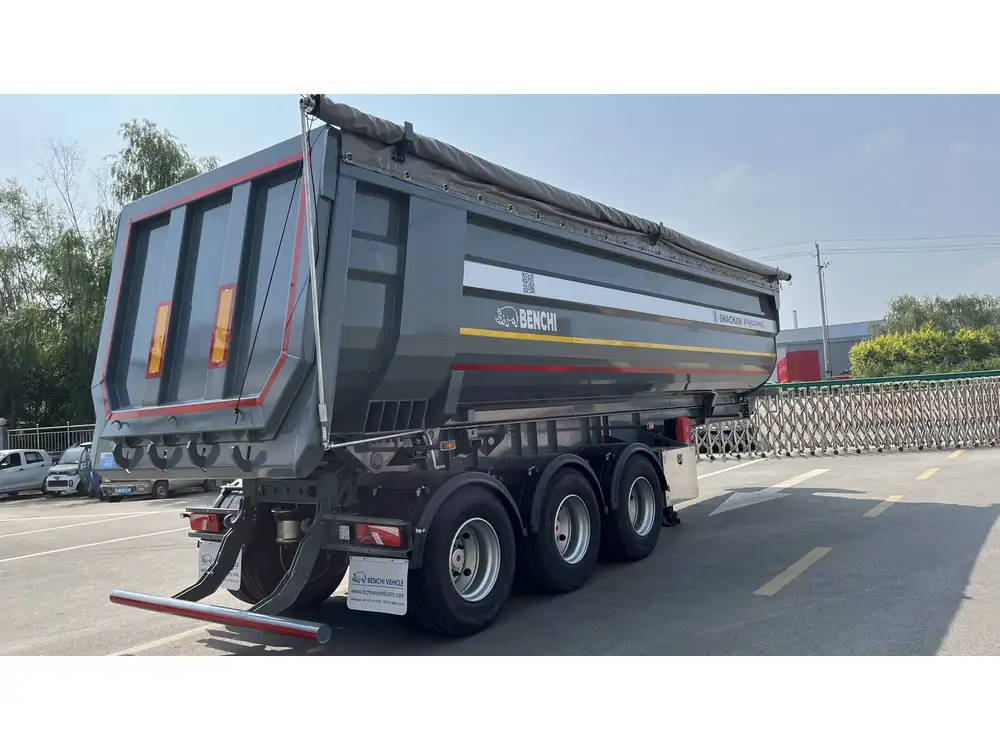Flatbed trailers are a key component in the transportation industry, renowned for their versatility and efficiency in hauling various types of cargo. Among these, the 53 ft flatbed trailer is a common choice for freight companies due to its optimal length for transporting long or heavy loads. However, understanding the legal regulations regarding maximum length can be challenging and varies by jurisdiction. In this article, we will delve deeper into these regulations, dimensions, types of loads, safety concerns, and industry best practices related to 53 ft flatbed trailers.
1. Key Dimensions of a 53 ft Flatbed Trailer
Here are the fundamental dimensions and specifications of a standard 53 ft flatbed trailer that every professional should be familiar with:
| Feature | Measurement |
|---|---|
| Overall Length | 53 feet (16.15 m) |
| Overall Width | 8.5 feet (2.59 m) |
| Overall Height | 5 feet (1.52 m) |
| Maximum Load Capacity | 48,000 lbs (21,772 kg) |
| Deck Height | 38-42 inches (0.97-1.07 m) above ground |
1.1 Length Calculation
It’s important to understand how the length of the trailer affects the cargo it can carry. The standard load length is effectively utilized by perfectly matching it with the maximum allowable dimensions within the regulations set forth by the Federal Highway Administration (FHWA) and state laws.

2. Federal and State Regulations on Trailer Length
The maximum length allowed for a trailer can vary based on federal and state regulations. Below, we outline the basics of these regulations:
2.1 Federal Guidelines
According to FHWA:
Interstate Highways: For trucks operating on interstate highways, the maximum trailer length permitted is generally 53 feet. This rule allows carriers to transport larger loads across states within a single trailer.
Highway Safety: The regulations are designed to maintain safety on roads, ensuring that long trailers are handled with adequate clearance and stability.
2.2 State Regulations
State requirements may deviate significantly, affecting the legal maximum length of flatbed trailers. Some key points include:
- Length Limits: Some states permit longer trailers specifically for agricultural or specialized loads. Some may impose a stricter maximum length (e.g., 48 feet).
- Permits for Oversized Loads: If loads exceed legal limits, oversized load permits are required, which may come with specific routing regulations to avoid hazardous areas.

2.3 Summary of States with Unique Regulations
| State | Maximum Length (ft) | Notes |
|---|---|---|
| California | 53 | Standard for interstate travel |
| Texas | 53 | No additional restrictions |
| Florida | 53 | Special permits for special cargo |
| New York | 48 | Requires special permits |
3. Types of Loads that Benefit from 53 ft Flatbed Trailers
Understanding the types of cargo best suited for 53 ft flatbed trailers can help manufacturers and logistics managers optimize transportation logistics effectively.
3.1 Common Cargo Types
- Construction Materials: Lumber, steel beams, and concrete blocks can be easily transported.
- Heavy Machinery: Equipment such as bulldozers and excavators due to their weight and size.
- Vehicles: Transporting cars, trucks, and motorcycles.
- Industrial Equipment: Large turbines, generators, and other oversized components.

3.2 Specialized Loads
- Wind Turbine Components: Their size requires special handling, often necessitating additional permits.
- Conventional Freight: Palletized goods, which may benefit from the flat, stable deck of a flatbed trailer.
3.3 Securing Your Load
To maximize safety, understanding proper load securing techniques is essential. Ensure that:
- Straps and Chains: Use appropriate tie-downs to secure heavier loads.
- Tarps: For weather-sensitive items, tarping is crucial to protect against the elements.
4. Safety Considerations for Operating 53 ft Flatbed Trailers
Safety should always remain a priority when handling flatbed trailers. Here, we discuss essential safety practices:

4.1 Pre-Trip Inspections
Conduct a thorough inspection of the trailer before every journey. Check:
- Tires: Ensure proper inflation and tread depth.
- Lights: Verify all lights are operational.
- Brakes: Test brake functionality to prevent accidents.
4.2 Load Distribution
Proper load distribution helps maintain balance while driving. Distribute weight evenly across the trailer by following these steps:
- Place heavier items closer to the axles.
- Secure lighter items at the back while ensuring they are stable.
4.3 Road Awareness
Drivers should remain alert to their surroundings, especially:
- Turns and Corners: Utilize wider turns to avoid potential accidents.
- Road Conditions: Be mindful of weather-induced hazards, like slippery roads or potholes.

5. Frequently Asked Questions (FAQs)
5.1 What is the maximum length allowed for a 53 ft flatbed trailer in all states?
Typically, the maximum length allowed for a 53 ft flatbed trailer is indeed 53 feet, but variations exist by state, sometimes reaching 65 feet with special permits.
5.2 Are there special licenses required to operate trailers of this length?
Yes, depending on the weight in combination with other vehicles, a Commercial Driver’s License (CDL) may be necessary to operate a 53 ft flatbed trailer.

5.3 Can I use a 53 ft flatbed trailer for heavy machinery transport?
Absolutely. 53 ft flatbed trailers are ideal for heavy machinery transport, provided the equipment fits within the weight limits and dimensions stipulated by local regulations.
6. Conclusion
As industry leaders in the manufacturing of semi-trailers, we believe that thorough knowledge of industry standards, legal regulations, and proper safety practices regarding the length and operation of 53 ft flatbed trailers is essential for successful transportation management.
By adhering to the guidelines outlined in this article, you can enhance safety, optimize load handling, and ensure compliance with federal and state regulations regarding maximum trailer lengths. We encourage experienced and novice drivers alike to continually educate themselves on changes in laws and enhancements in trailer technology to stay ahead in the dynamic logistics landscape.
Continuously investing in both knowledge and the right equipment will not only guarantee safety on the roads but will also foster efficient and timely deliveries. Your investment in understanding these aspects of trailer management pays dividends in performance and reliability, ultimately leading to enhanced customer satisfaction and operational excellence.
Ensure that the next time you’re operating a 53 ft flatbed trailer, you do so with confidence, armed with the knowledge necessary for a successful journey.



